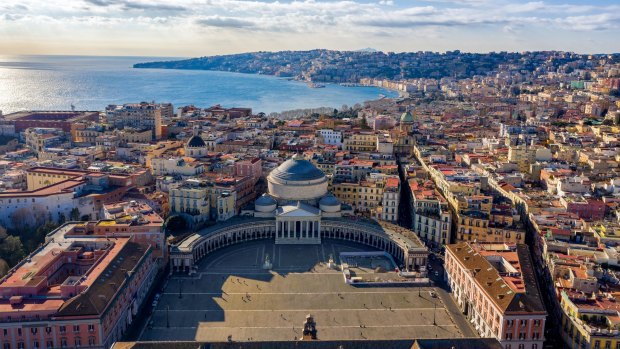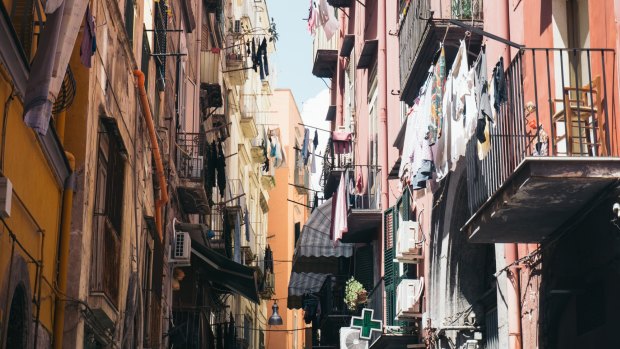This was published 4 years ago
Why Naples is one of the most passionate and likeable of all Italian cities

Naples is set around a beautiful bay.Credit: Getty Images
They have a favourite pastry in Naples, the sfogliatella. Made from crunchy pastry layers dusted with icing sugar and often a dollop of creamy ricotta at its heart, "sfogliatella" means something like "little thin sheets" and if you're looking for a metaphor for Naples, this is it. Naples is a city of layers.
Give it a cursory glance and you'll see a city falling apart. Exhausted, stained with grime and graffiti, mad, bad and dangerous by repute, Naples sits some way down on the travel hot lists. Yet for those prepared to sail in with an open mind, Naples is one of the most passionate, authentic and likeable of all Italian cities. You just need to peel back the layers.
Crammed into the narrow shelf between the waterfront and the steep ramp of the Vomero district, the heart of Naples feels tight. The streets are narrow canyons overshadowed by cliff-like apartments, too narrow for traffic for the most part, except for the helmetless teens who slalom their Vespas through the twisting alleyways. Beware!

Laundry lines criss-cross the narrow streets.Credit: Stocksy
This is a city that bares its soul in public. Washing lines ladder the narrow chasms between the city's housing blocks, and laundry fluttering across the skyline is the flag of Naples. Something as mundane as hanging out the washing becomes a public spectacle that involves neighbourly chats across the gap in a tribal coming-together.
Nor do mobile phone signals penetrate well into the vertiginous cityscape of old Naples. To make a call its citizens must lean out from their balconies and windows, and their conversations are never quiet. Neapolitan communication is underpinned by a rich lexicon of facial contortions and gesticulations. Arms are flung, faces animate, laughs are louder here than in other parts of Italy and arguments more barbed.
Pizza was invented in Naples, where it is believed there are just two kinds of pizzas. One is with tomato, the marinara, and has nothing to do with the sea. The other is the margherita, tomato plus mozzarella and basil, the colours of the Italian flag. Neapolitan pizzas are soft rather than crispy, banked up on the sides to make a shallow dish. Pizzeria Brandi, tucked into a laneway off Via Chiaia, claims to be the originator and has been dishing out margheritas ever since.
Naples sees far fewer tourists than it deserves given its cultural splendours. The National Archaeological Museum is a standout, with the fabulous Farnese Collection at its core.
A rich and powerful Roman family, the Farneses plundered the Forum, the Baths of Caracalla and anything else they could get their hands on and installed the lot in Palazzo Farnese in Rome. Late in the 18th century, the collection was transferred to Naples.
As well as one of the finest collections of Greco-Roman antiquities, the museum also features some of the best artworks excavated from the Vesuvius towns of Pompeii and Hurculaneum in the aftermath of the volcano's eruption – paintings, mosaics, jewellery and domestic objects that show a rich and sophisticated culture with a taste for leisure. Also one with a surprising enthusiasm for erotic artworks, seen in the museum's small but well patronised Secret Cabinet.
One of the best views of the city is from Belvedere di San Martino, from where the city spreads out with the curve of the bay at your feet, the finger of the Sorrentine Peninsula pointing towards Capri. The view reaches its climax at sundown, when the bay turns to liquid gold, but you can't ignore the black cone of Vesuvius brooding on the edge of the bay.
Neapolitans have an obsession with the afterlife. Death is fetishised in Naples, and nowhere more so than in its churches. The most spectacular is the cathedral dedicated to San Gennaro, the city's patron saint. You've never seen a more giddily decorated church, where no surface is left unadorned. Three times each year the church is packed with worshippers when a sealed glass vial of the saint's dried blood is brought out and miraculously liquifies on cue.
My favourite, though, is the Chapel of Sansevero, the creation of Prince Raimondo di Sangro, known as the Leonardo da Vinci of 18th-century Naples. Di Sangro commissioned a series of marble statues that for sheer finesse rival the works of Bernini and Michelangelo. Every detail – rose garlands, hair, eyes, fingernails – is cast in exquisite detail.
In the spectacular The Release from Deception, a male figure struggles free from a net carved from a single piece of marble. The statues depict the virtues – divine love, sincerity, decorum – but you can't help noticing that Modesty is clearly competing in a wet T-shirt event.
A theatrically veiled Christ lies under a marble shroud so realistic you'd swear it was shrink wrapped.
One layer you really must peel open is the underground church of Santa Maria della Anime del Purgatorio ad Arco, a ghoulish assembly of skeletal remains, the centre of the city's "cult of the dead". And don't miss the underground tour of the stone quarries off Via dei Tribunali, where the volcanic rock from which much of the city is built was hacked out.
A final recommendation – begin each day with a sfogliatella. Wash it down with a zuccherato, the default Neapolitan espresso, the usual Italian thimble of rocket fuel stoked with a spoonful of sugar and strong enough to blow your head off. You're now ready to face whatever Naples is going to throw your way this day.
This article appears in Sunday Life magazine within the Sun-Herald and the Sunday Age on sale December 15.
Sign up for the Traveller Deals newsletter
Get exclusive travel deals delivered straight to your inbox. Sign up now.